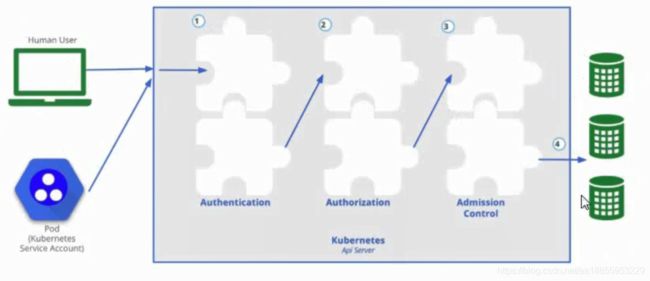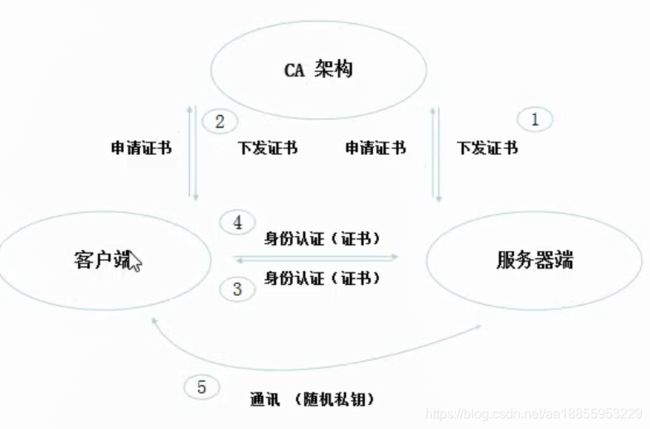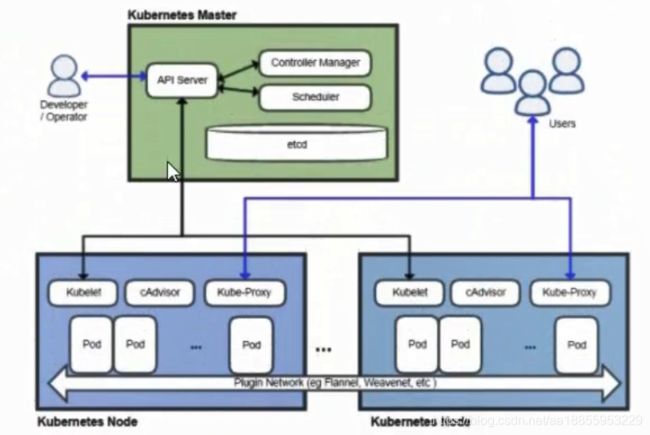第六课:尚硅谷K8s学习-k8s资源调度器和安全认证
第六课:尚硅谷K8s学习-k8s资源调度器和安全认证
tags:
- golang
- 2019尚硅谷
categories:
- K8s
- 集群调度
- 安全认证
文章目录
- 第六课:尚硅谷K8s学习-k8s资源调度器和安全认证
-
- 第一节 集群调度介绍
-
- 1.1 调度器-调度简介
- 1.2 调度器-调度过程
- 第二节 调度的亲和性
-
- 2.1 节点亲和性
- 2.2 Pod亲和性
- 2.3 Taint(污点)介绍
- 2.4 Toleration(容忍)的介绍
- 2.5 指定调度节点
- 第三节 集群的安全机制
-
- 3.1 安全机制-认证
- 3.2 安全机制-鉴权介绍
- 3.3 Role and ClusterRole、RoleBinding and ClusterRoleBinding说明
- 3.4 Resource和to Subjects介绍
- 3.5 实践:创建一个用户只能管理dev空间
- 3.6 安全机制-准入控制
第一节 集群调度介绍
1.1 调度器-调度简介
- Scheduler是kubernetes中的调度器组件,主要的任务是把定义的pod分配到集群的节点上。听起来非常简单,但有很多要考虑的问题:
- 公平: 如何保证每个节点都能被分配
- 资源资源高效利用: 集群所有资源最大化被使用
- 效率: 调度的性能要好,能够尽快地对大批量的pod完成调度工作
- 灵活: 允许用户根据自己的需求控制调度的逻辑
- Sheduler是作为单独的程序运行的,启动之后会一直监听APIServer,获取PodSpec.NodeName为空的pod,对每个pod都会创建一个binding,表明该 pod 应该放到哪个节点上。
- 这里的PodSpec.NodeName不为空的pod,说明我们手动指定了这个pod应该部署在哪个node上,所以这种情况Sheduler就不需要参与进来了.
1.2 调度器-调度过程
-
调度过程分为两部分,如果中间任何一步骤有错误,直接返回错误:
- predicate(预选): 首先是过滤掉不满足条件的节点
- priority(优选): 然后从中选择优先级最高的节点
-
**Predicate(预选)**有一系列的算法可以使用:
- PodFitsResources: 节点上剩余的资源是否大于pod请求的资源
- Podfitshost: 如果pod指定了NodeName,检查节点名称是否和NodeName相匹配
- PodFfitsHostPorts: 节点上已经使用的port是否和 pod申请的port冲突
- PodSelectorMatches: 过滤掉和 pod指定的label不匹配的节点
- NoDiskConflict: 已经mount的volume和 pod指定的volume不冲突,除非它们都是只读
-
注意:如果在predicate过程中没有合适的节点。pod会一直在pending状态,不断重试调度,直到有节点满足条件。经过这个步骤,如果有多个节点满足条件,就继续priorities过程
-
**Priorities(优选)**是按照优先级大小对节点排序
-
优先级由一系列键值对组成,键是该优先级项的名称,值是它的权重(该项的重要性)。这些优先级选项包括:
- LeastRequestedPriority:通过计算CPU和 Memory的使用率来决定权重,使用率越低权重越高。换句话说,这个优先级指标倾向于资源使用比例更低的节点
- BalancedResourceA1location:节点上CPU和Memory 使用率越接近,权重越高。这个应该和上面的一起使用,不应该单独使用
- ImageLocalityPriority:倾向于已经有要使用镜像的节点,镜像总大小值越大,权重越高
-
通过算法对所有的优先级项目和权重进行计算,得出最终的结果。上面只是常见的算法,还有很多算法可以到官网查阅。
第二节 调度的亲和性
2.1 节点亲和性
- node节点亲和性: 简单来理解就是,指定调度到的node,nodeAffinity分为两种pod.spec.nodeAffinity:
- preferredDuringSchedulinglgnoredDuringExecution:软策略【我想要去这个节点】
- requiredDuringschedulinglgnoredDuringExecution:硬策略【我一定要去这个节点】
- node节点亲和性硬策略示例:requiredDuringSchedulingIgnoredDuringExecution
-
- kubectl get pod -o wide
-
apiVersion: v1
kind: Pod
metadata:
name: affinity
labels:
app: node-affinity-pod
spec:
containers:
- name: with-node-affinity
image: hub.qnhyn.com/library/myapp:v1
affinity:
# 指定亲和性为node亲和性
nodeAffinity:
# 指定为硬策略
requiredDuringSchedulingIgnoredDuringExecution:
nodeSelectorTerms:
# key就是node的label
# 这句话代表当前pod一定不能分配到k8s-node02节点上
- matchExpressions:
- key: kubernetes.io/hostname # 标签的键名kubectl get node --show-labels查看
operator: NotIn
values:
- k8s-node2
- node亲和性软策略示例:preferredDuringSchedulingIgnoredDuringExecution。
- kubectl get pod -o wide
apiVersion: v1
kind: Pod
metadata:
name: affinity
labels:
app: node-affinity-pod
spec:
containers:
- name: with-node-affinity
image: hub.qnhyn.com/library/myapp:v1
affinity:
# 声明节点亲和性为软策略
nodeAffinity:
preferredDuringSchedulingIgnoredDuringExecution:
# 当前策略权重为1
- weight: 1
preference:
# [最好]能分配到label为source=k8s-node03的节点上
matchExpressions:
- key: source
operator: In
values:
- k8s-node03
- 若软策略和硬策略同时存在。要先满足我们的硬策略在满足软策略才行。
- 键值运算关系
- In: label的值在某个列表中
- Notin: label 的值不在某个列表中
- Gt: label的值大于某个值
- Lt: label的值小于某个值
- Exists:某个label存在
- DoesNotExist: 某个label不存在
2.2 Pod亲和性
- pod亲和性主要解决pod可以和哪些pod部署在同一个拓扑域中的问题
- 拓扑域: 用主机标签实现,可以是单个主机,或者具有同个label的多个主机,也可以是多个主机组成的 cluster、zone 等等
- 所以简单来说: 比如一个 pod 在一个节点上了,那么我这个也得在这个节点,或者你这个 pod 在节点上了,那么我就不想和你待在同一个节点上
- pod亲和性/反亲和性又分为两种:pod.spec.affinity.podAffinity/podAntiAffinity:
- preferredDuringSchedulinglgnoredDuringExecution:软策略
- requiredDuringSchedulinglgnoredDuringExecution:硬策略
apiVersion: v1
kind: Pod
metadata:
name: pod-3
labels:
app: pod-3
spec:
containers:
- name: pod-3
image: hub.qnhyn.com/library/myapp:v1
affinity:
# 配置一条pod亲和性策略
podAffinity:
# 配置为硬策略 kubectl get pod --show-labels labels是app=pod1的pod同一拓扑域
requiredDuringSchedulingIgnoredDuringExecution:
- labelSelector:
matchExpressions:
- key: app
operator: In
values:
- pod-1
topologyKey: kubernetes.io/hostname
# 配置一条pod反亲和性策略
podAntiAffinity:
# 配置为软策略
preferredDuringSchedulingIgnoredDuringExecution:
- weight: 1
podAffinityTerm:
labelSelector:
matchExpressions:
- key: app
operator: In
values:
- pod-2
topologyKey: kubernetes.io/hostname
-
亲和性/反亲和性调度策略比较
调度策略 匹配标签 操作符 拓扑域支持 调度目标 nodeAffinity 主机 IN, NotIn, Exists, DoesNotExist, Gt, Lt 否 指定主机 podAffinity POD IN, NotIn, Exists, DoesNotExist 是 POD与指定POD同一拓扑域 podAntiAffinity POD IN, NotIn, Exists, DoesNotExist 是 POD与指定POD不在同一拓扑域
2.3 Taint(污点)介绍
- 节点亲和性是pod的一种属性(偏好或硬性要求),它使pod被吸引到一类特定的节点。Taint则相反,它使节点能够排斥一类特定的pod。
- Taint和toleration相互配合,可以用来避免pod被分配到不合适的节点上。每个节点上都可以应用一个或多个taint,这表示对于那些不能容忍这些taint的pod,是不会被该节点接受的。如果将toleration 应用于pod上,则表示这些pod 可以(但不要求)被调度到具有匹配 taint 的节点上。
- 如果没有特别配置toleration,默认是不容忍所有污点的
- 使用kubectl taint 命令可以给某个Node节点设置污点,Node被设置上污点之后就和Pod之间存在了一种相斥的关系,可以让Node拒绝Pod的调度执行,甚至将Node已经存在的Pod驱逐出去
- 污点的value是可选项,即污点有两种组成形式:
key=value:effect
key:effect
- 每个污点有一个key和value作为污点的标签,其中value可以为空,effect 描述污点的作用。当前taint effect支持如下三个选项:
- NoSchedule:表示k8s将不会将Pod调度到具有该污点的Node上
- PreferNoschedulel: 表示k8s将尽量避免将Pod调度到具有该污点的Node上
- NoExecute: 表示k8s将不会将Pod调度到具有该污点的Node上,同时会将Node上已经存在的Pod驱逐出去
- kubectl describe node k8s-master 主节点上本身就有一个NoSchedule的污点,默认不在上面创建Pod。
# 设置污点
kubectl taint nodes node1 key1=value1:NoSchedule
# 例子
kubectl taint nodes k8s-node1 check=qnhyn:NoExecute
# 节点说明中,查找Taints字段
kubectl describe pod pod-name
# 去除污点 通过describe查看污点,然后把污点复制出来,按照如下格式在最后加一个-就好了
kubectl taint nodes node1 key1:NoSchedule-
# 例子:
kubectl taint nodes k8s-node1 check=qnhyn:NoExecute-
2.4 Toleration(容忍)的介绍
- 设置了污点的Node将根据taint的effect:NoSchedule、PreferNoSchedule、NoExecute 和 Pod之间产生互斥的关系,Pod将在一定程度上不会被调度到Node上
- 但我们可以在Pod上设置容忍(Toleration)。意思是设置了容忍的Pod将可以容忍污点的存在,可以被调度到存在污点的Node上
- 可以被调度不代表一定会被调度,只是保存了可能性
- Toleration的资源清单配置:
tolerations:
# 容忍key1-value1:NoSchedule的污点
# 且需要被驱逐时,可以再呆3600秒
- key: "key1"
operator: "Equal"
value: "value1"
effect: "NoSchedule"
# 用于描述当Pod需要被驱逐时可以在 Pod上继续保留运行的时间
tolerationSeconds: 3600
# 容忍key1-value1:NoExecute的污点
- key: "key1"
operator: "Equal"
value: "value1"
effect: "NoExecute"
# 容忍key2:NoSchedule的污点
- key:"key2"
operator: "Exists"
effect: "NoSchedule"
- 注意点
- key,value, effect要与Node上设置的 taint保持一致
- operator的值为Exists将会忽略value值,如不指定operator,则默认为equal
- tolerationSeconds用于描述当Pod需要被驱逐时可以在 Pod上继续保留运行的时间
- 当不指定key值时,表示容忍所有的污点key
tolerations:
- operator: "Exists"
- 当不指定effect时,表示容忍所有的污点作用
tolerations:
- key: "key"
operator: "Exists"
- 有多个Master存在时,防止资源浪费,可以如下设置(尽可能不在master上运行)
kubectl taint nodes Node-Name node-role.kubernetes.io/master=:PreferNoSchedule
2.5 指定调度节点
- 通过指定Pod.spec.nodeName将Pod直接调度到指定的Node节点上(根据节点的名称选择)
- 会跳过Scheduler的调度策略
- 该匹配规则是强制匹配
apiVersion: apps/v1
kind: Deployment
metadata:
name: myweb
spec:
replicas: 7
selector:
matchLabels:
app: myweb
template:
metadata:
labels:
app: myweb
spec:
# 直接指定node名称 七个Pod全在k8s-node1上
nodeName: k8s-node1
containers:
- name: myweb
image: hub.qnhyn.com/library/myapp:v1
ports:
- containerPort: 80
- Pod.spec.nodeSplector: 通过kubernetes的label-selector机制选择节点,由调度器调度策略
匹配label,而后调度Pod到目标节点,该匹配规则属于强制约束(根据标签选择)- kubectl label node k8s-node1 disk=ssd 给节点打个标签
apiVersion: apps/v1
kind: Deployment
metadata:
name: myweb
spec:
replicas: 7
selector:
matchLabels:
app: myweb
template:
metadata:
labels:
app: myweb
spec:
# nodeSplector
nodeSplector:
disk: ssd # 标签为硬盘类型为ssd的
containers:
- name: myweb
image: hub.qnhyn.com/library/myapp:v1
ports:
- containerPort: 80
第三节 集群的安全机制
3.1 安全机制-认证
-
Kubernetes作为一个分布式集群的管理工具,保证集群的安全性是其一个重要的任务。 API Server是集群内部各个组件通信的中介,也是外部控制的入口。所以Kubernetes的安全机制基本就是围绕保护API Server来设计的。Kubernetes 使用了认证(Authentication) 、鉴权(Authorization) 、准入控制(Admission Control)三步来保证API Server的安全

-
Authentication认证方式有以下几种:
- HTTP Token认证:通过一个Token来识别合法用户(不太安全,文件且单向认证)
- HTTP Token的认证是用一个很长的特殊编码方式的并且难以被模仿的字符串- Token来表达客户的一种方式。Token 是一个很长的很复杂的字符串,每个Token对应一个用户名存储在API Server能访问的文件中。当客户端发起API调用请求时,需要在HTTP Header里放入Token
- HTTP Base认证:通过用户名+密码的方式认证(不太安全,单向认证)
- 用户名+密码用BASE64算法进行编码后的字符串放在HTTP Request中的Heather Authorization域里发送给服务端,服务端收到后进行编码,获取用户名及密码
- 最严格的HTTPS证书认证**:基于CA根证书签名的客户端身份认证方式**(双向认证)
- HTTP Token认证:通过一个Token来识别合法用户(不太安全,文件且单向认证)
-
两种类型
- Kubenetes 组件对API Server的访问: kubectl、Controller Manager、Scheduler、 kubelet、 kube-proxy
- Kubernetes 管理的Pod对容器的访问: Pod (dashborad 也是以Pod形式运行)
-
安全性说明
- Controller Manager、 Scheduler与A[PI Server在同一台机器,所以直接使用API Server的非安全端口访问, --insecure -bind-address=127.0.0.1
- kubectl、 kubelet.、kube-proxy访问API Server就都需要证书进行HTTPS双向认证
-
证书颁发
- 手动签发:通过k8s集群的跟ca进行签发HTTPS证书
- 自动签发: kubelet首次访问API Server时,使用token做认证,通过后,Controller Manager会为kubelet生成一个证书, 以后的访问都是用证书做认证了
-
kubeconfig:既是集群的描述,又是集群认证信息的填充。
- kubeconfig文件包含集群参数(CA证书、API Server地址) .客户端参数(上面生成的证书和私钥) ,集群context信息(集群名称、用户名)。Kubenetes 组件通过启动时指定不同的kubeconfig文件可以切换到不同的集群
-
ServiceAccount
- Pod中的容器访问API Server。因为Pod的创建、销毁是动态的,所以要为它手动生成证书就不可行了。Kubenetes使用了Service Account解决Pod访问API Server的认证问题
-
Secret 与SA的关系
- Kubernetes设计了一种资源对象叫做Secret,分为两类,一种是用于ServiceAccount的service-account-token,另一种是用于保存用户自定义保密信息的Opaque。ServiceAccount 中用到包含三个部分: Token、ca.crt、namespace
- token是使用API Server私钥签名的JWT。用于访问API Server时,Server端认证
- ca.crt, 根证书。于Client端验证API Server发送的证书
- namespace, 标识这个service-account-token的作用域名空间
kubectl get secret --all-namespaces
kubectl describe secret default-token-5gm9r --namespace=kube-system
- 默认情况下,每个namespace都会有一个ServiceAccount,如果Pod在创建时没有指定ServiceAccount,就会使用Pod所属的namespace的ServiceAccount
3.2 安全机制-鉴权介绍
-
上面认证过程,只是确认通信的双方都确认了对方是可信的,可以相互通信。而鉴权是确定请求方有哪些资源的权限。API Server目前支持以下几种授权策略(通过 API Server的启动参数"-authorization-mode"设置)
- AIwaysDeny: 表示拒绝所有的请求,一般用于测试
- AlwaysAllow: 允许接收所有请求,如果集群不需要授权流程,则可以采用该策略(测试中可以用一下)
- ABAC (Attribute-Based Access Control) :基于属性的访问控制,表示使用用户配置的授权规则对用户请求进行匹配和控制。(已经过时了,需要重启)
- Webbook: 通过调用外部REST服务对用户进行授权(历史啦,集群内部就不可以操作)
- RBAC (Role-Based Access Control) :基于角色的访问控制,现行默认规则(好的,选择的)
-
RBAC (Role-Based Access Control)基于角色的访问控制,在Kubernetes 1.5中引入,现行版本成为默认标准。相对其它访问控制方式,拥有以下优势:
- 对集群中的资源和非资源均拥有完整的覆盖
- 整个RBAC完全由几个API对象完成,同其它API对象一样,可以用kubectl或API进行操作
- 可以在运行时进行调整,无需重启API Server
-
RBAC的API资源对象说明
-
需要注意的是Kubenetes并不会提供用户管理,那么User. Group. ServiceAccount 指定的用户又是从哪里来的呢? Kubenetes 组件(kubectl、 kube-proxy) 或是其他自定义的用户向CA申请证书时,要提供一个证书请求文件。用户名admin, 组system:masters
{
"CN": "admin",
"hosts": [],
"key": {
"algo": "rsa",
"size": 2048
},
"names": [
{
"C": "CN",
"ST": "HangZhou",
"L": "XS",
"O": "system:masters",
"OU": "System"
}
]
}
- API Server会把客户端证书的CN字段作为User,把names .o字段作为Group
- Kubelet使用TLS Bootstaping认证时,API Server可以使用Bootstrap Tokens或者Token authentication file验证= token,无论哪一种,Kubernetes都会为token绑定一个默认的User和Group
- Pod使用ServerAccount认证时,service-account-token 中的JWT会保存User信息
- 有了用户信息,再创建一对角色/角 色绑定(集群角色/集群角色绑定)资源对象,就可以完成权限绑定了
3.3 Role and ClusterRole、RoleBinding and ClusterRoleBinding说明
- 在 RBAC API 中,Role表示一组规则权限,权限只会增加 (累加权限,不存在一个资源一开始就有很多权限而通过 RBAC 对其进行减少的操作;Role可以定义在一个namespace中,如果想要跨namespace则可以创建ClusterRole
kind: Role
apiVersion: rbac.authorization.k8s.io/v1beta1
metadata:
namespace: default
name: pod-reader
rules:
- apiGroups: [""] # "" indicates the core API group 不写代表core的核心组
resources: ["pods"]
verbs: ["get","watch","list"] # 如果把这个role给某个用户,这个用户就可以在default的名称空间下获取、监听、列出pod
- ClusterRole 具有与Role 相同的权限角色控制能力,不同的是ClusterRole是集群级别的,ClusterRole可以用于
- 集群级别的资源控制(例如 node 访问权限)
- 非资源类型 endpoints(例如 /healthz 访问)
- 所有命名空间资源控制(例如pods)
kind: ClusterRole
apiVersion: rbac.authorization.k8s.io/v1beta1
metadata:
# "namespace" omitted since ClusterRole are not namespaced
name: secret-reader
rules:
- apiGroups: [""]
resources: ["secrets"]
verbs: ["get","watch","list"]
- RoleBinding 可以将角色中定义的权限授予用户或用户组,RoleBinding 包含一组权限列表(subjects)权限列表包含有不同形式的待授予权限资源类型(users,groups,or service accounts)。RoleBinding 同样包含对被Bind 的Role引用;RoleBinding 适用于某个命名空间内授权,而 ClusterRoleBinding 适用于集群范围内的授权
- RoleBinding可以绑定Role或ClusterRole,但是 ClusterRoleBinding只能绑定 ClusterRole
- 将default 命令空间的 pod-reader Role 授予 jane 用户,此后jane 用户在default 命名空间中具有 pod-reader的权限
kind: RoleBinding
apiVersion: rbac.authorization.k8s.io/v1beta1
metadata:
name: read-pods
namespace: default
subjects:
- kind: User
name: jane
apiGroup: rbac.authorization.k8s.io
roleRef:
kind: Role
name: pod-reader
apiGroup: rbac.authorization.k8s.io
- RoleBinding 同样可以引用ClusterRole 来对当前namespace 内用户、用户组或ServiceAccount进行授权,这种操作允许集群管理员在整个集群内定义一些通用的ClusterRole,然后在不同的namespace中使用RoleBinding来引用
- 例如,以下RoleBinding 引用了一个ClusterRole,这个ClusterRole 具有整个集群内对secrets的访问权限;但是其授权用户dave只能访问development空间中的secrets(因为RoleBinding 定义在development命名空间)
# This role binding allows "dave" to read secrets in the "development" namespace.
kind: RoleBinding
apiVersion: rbac.authorization.k8s.io/v1beta1
metadata:
name: read-secrets
namespace: development # This only grants permissions within the "development' namespace
subjects:
- kind: User
name: dave
apiGroup: rbac.authorization.k8s.io
roleRef:
kind: ClusterRole
name: secret-reader
apiGroup: rbac.authorization.k8s.io
- 使用ClusterRoleBinding 可以对整个集群中的所有命名空间资源权限进行授权;以下ClusterRoleBinding 样例展示了授权manager组内所有用户在全部命名空间中对secrets进行访问
# This cluster role binding allows anyone in the "manager" group to read secrets in any namespace
kind: ClusterRoleBinding
apiVersion: rbac.authorization.k8s.io/v1beta1
metadata:
name: read-secrets-global
subjects:
- kind: Group
name: manager
apiGroup: rbac.authorization.k8s.io
roleRef:
kind: ClusterRole
name: secret-reader
apiGroup: rbac.authorization.k8s.io
3.4 Resource和to Subjects介绍
- Kubernetes 集群内一些资源一般以其名称字符串来表示,这些字符串一般会在 API 的URL地址中出现;同时某些资源也会包含子资源,例如logs资源就属于pods的子资源,API中URL样例如下:
GET /api/v1/namespaces/{namespace}/pods/{name}/log
- 如果要在RBAC授权模型中控制这些子资源的访问权限,可以通过/分隔符来实现,以下是一个定义pods资源logs访问权限的Role定义样例
kind: Role
apiVersion: rbac.authorization.k8s.io/v1beta1
metadata:
namespace: default
name: pod-and-pod-logs-reader
rules:
- apiGroups: [""]
resources: ["pods","pods/log"]
verbs: ["get","list"]
- RoleBinding 和 ClusterRoleBinding 可以将Role绑定到Subjects;Subjects可以是groups、users、或者service accounts
- Subjects 中Users 使用字符串表示,它可以是一个普通的名字字符串,如 “alice”;也可以是email格式的邮箱地址,例如”[email protected]“;甚至是一组字符串形式的数字ID。但是Users的前缀system:是系统保留的,集群管理员应该确保普通用户不会使用这个前缀格式。
- Groups 书写格式与Users相同,都为一个字符串,并且没有特定的格式要求;同样system:前缀为系统保留
3.5 实践:创建一个用户只能管理dev空间
# 先创建一个用户
useradd devuser
passwd devuser
mkdir -p /usr/local/install-k8s/cert
cd /usr/local/install-k8s/cert
mkdir devuser && cd devuser
# 创建访问证书请求
vim devuser-csr.json
{
"CN":"devuser",
"hosts":[],
"key": {
"algo": "rsa",
"size": 2048
},
"names": [
{
"C": "CN",
"ST": "BeiJing",
"L": "BeiJing",
"O": "k8s",
"OU": "System"
}
]
}
# 下载证书生成工具
wget https://pkg.cfssl.org/R1.2/cfssl_linux-amd64
wget https://pkg.cfssl.org/R1.2/cfssljson_linux-amd64
wget https://pkg.cfssl.org/R1.2/cfssl-certinfo_linux-amd64
chmod a+x *
mv cfssl_linux-amd64 /usr/local/bin/cfssl
mv cfssljson_linux-amd64 /usr/local/bin/cfssljson
mv cfssl-certinfo_linux-amd64 /usr/local/bin/cfssl-certinfo
cd /etc/kubernetes/pki/
# 创建证书请求和证书私钥
cfssl gencert -ca=ca.crt -ca-key=ca.key -profile=kubernetes /usr/local/install-k8s/cert/devuser/devuser-csr.json | cfssljson -bare devuser
# 设置集群参数
cd /usr/local/install-k8s/cert/devuser
export KUBE_APISERVER="https://192.168.1.10:6443"
kubectl config set-cluster kubernetes \
--certificate-authority=/etc/kubernetes/pki/ca.crt \
--embed-certs=true \
--server=${KUBE_APISERVER} \
--kubeconfig=devuser.kubeconfig
# 设置客户端认证参数
kubectl config set-credentials devuser \
--client-certificate=/etc/kubernetes/pki/devuser.pem \
--client-key=/etc/kubernetes/pki/devuser-key.pem \
--embed-certs=true \
--kubeconfig=devuser.kubeconfig
# 设置上下文参数 帮我们绑定到某个名称空间dev
# 创建名称空间dev
kubectl create namespace dev
kubectl config set-context kubernetes \
--cluster=kubernetes \
--user=devuser \
--namespace=dev \
--kubeconfig=devuser.kubeconfig
# 创建一个rolebinging绑定clusterrole 绑定到命名空间dev.admin可以在dev中为所欲为
kubectl create rolebinding devuser-admin-binding --clusterrole=admin --user=devuser --namespace=dev
mkdir -p /home/devuser/.kube/
cp devuser.kubeconfig /home/devuser/.kube/
chown devuser:devuser /home/devuser/.kube/devuser.kubeconfig
cd /home/devuser/.kube/ && mv devuser.kubeconfig config
# 切换上下文 让kubectl读取我们的配置信息
kubectl config use-context kubernetes --kubeconfig=config
# 然后在devuser用户下测试权限
kubectl get pod
kubectl run nginx --image=hub.qnhyn.com/library/myapp:v1
kubectl get pod --all-namespaces
3.6 安全机制-准入控制
- 准入控制**(建议默认的准入控制**)是API Server的插件集合,通过添加不同的插件,实现额外的准入控制规则。甚至于API Server的一些主要的功能都需要通过Admission Controllers实现,比如ServiceAccount
- 官方文档上有一份针对不同版本的准入控制器推荐列表:
NamespaceLifecycle,LimitRanger,ServiceAccount,DefaultStorageClass,DefaultTolerationSeconds,MutatingAdmissionWebhook,ValidatingAdmissionWebhook,ResourceQuota
- 列举几个插件的功能:
- NamespaceLifecycle:防止不存在的namespace上创建对象,防止删除系统预置 namespace,删除namespace时,连带删除它的所有资源对象。
- LimitRanger: 确保请求的资源不会超过资源所在Namespace的LimitRange的限制。
- ServiceAccount:实现了自动化添加ServiceAccount。
- ResourceQuota:确保请求的资源不会超时资源的ResourceQuota限制。



